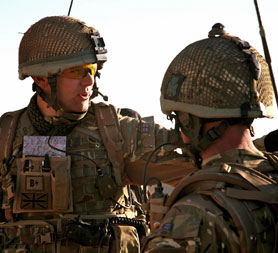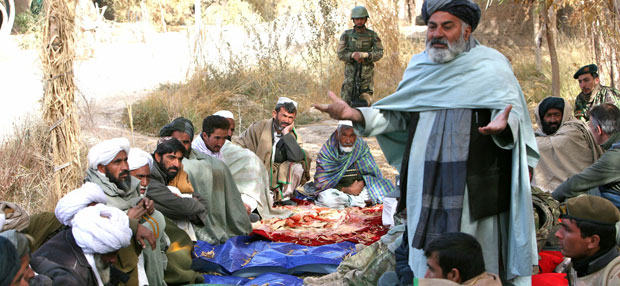Afghanistan: nearly ten years, what progress in Helmand?
As the war in Afghanistan approaches a milestone, Captain Doug Beattie writes from the Helmand frontline on how progress only comes with a price paid by both soldiers and the local population.

Captain Doug Beattie of 1 Royal Irish Regiment won the Military Cross for bravery in Afghanistan. He writes exclusively for Channel 4 News on his return to the frontline.
As a country, we are approaching some unwelcome milestones. Later in 2011 it will be a decade since British troops first entered Afghanistan in the aftermath of the Twin Towers 9/11 attack, and five years of operations in Helmand province.
This prolonged intervention has changed lives, and not just for the locals. Afghanistan is not just a passing phase for soldiers, but a central, enduring part of their professional and personal existences.
I am mid-way through my third tour of Helmand and I am not alone.
There are many soldiers who now have a wide and deep perspective of how the country has been changing provided by repeated exposure to the place.
We come, we see, we act and we go. Twelve or 18 months later we return to find out what has altered since our last period of intervention. We are in a privileged position and as much as anyone it is our views from the ground that should help shape policy. After all, which other outsiders have the insight into the success – or otherwise – of the campaign that we veterans do?
The effect on the locals is easily visible. They get used to having relative peace and stability.
In the early days it was places like Kajaki, Sangin, Musa Qala and Garmsir that became synonymous with our activity in Helmand and resonated in the public consciousness.
Stability
But since the strengthening of American Forces in 2010 and Operation Moshtarak last summer the British sphere of influence has shifted towards the more heavily populated central belt that includes the provincial capital Lashkah Gah. It also embraces Nad-e-Ali encompassing the Saidabad area, currently home to 1 Royal Irish regiment (R IRISH) and hence me.
The military counter insurgency strategy – prosecuted with significant and valuable input from the Afghan security forces – has been to dislocate and isolate the insurgency; neutralise the Taliban by securing the population. To a great extent this approach has been a success in the R IRISH area, with the largest number of enemy fighters killed or captured in a three-month period for over two years.
The effect on the locals is easily visible. They get used to having relative peace and stability. Like people everywhere they have a hunger for concord. The calm also allows for self-determination.
The tribal elders, provincial politicians and district police chiefs can do their jobs and exert their influence, link the population to the Government through the District Community Council.

To the outsider, the progress we make might not be immediately obvious, meaningful or substantial. Where, they might ask, is the significance in children splashing about in puddles wearing bright yellow Wellington boots dished out by the young Rangers?
The importance is in the confidence with which the gifts are received and used, without fear of chastisement or retribution from the Taliban. It reflects an acceptance of ISAF forces and a belief that the Afghans themselves will continue to guarantee security once we have departed.
Confidence and progress
There is also confidence to be seen in the bazaar of Saidabad Kalay. A ramshackle parade of shops, it was boarded up and lifeless when we arrived. Today commerce is healthy. Street lighting is also now in place and plans have been approved to black-top the road. Trading has extended beyond the confines of the village with produce regularly leaving for Lashkah Gah.
People are also to be seen working in the fields, clearing debris from the canals and irrigation ditches, and preparing to refurbish the school and medical clinic.
It would be naïve to think we will beat the Taliban militarily, but we can drive a wedge between them and those they seek to manipulate, the ordinary people. If Afghans believe their future will be best ensured by backing the Government of the Islamic Republic of Afghanistan then the insurgents’ constituency will shrink together with their influence.
It is a soldier’s lot to serve and to suffer when required.
In the short term this might result in increasing violence as they attempt to exert control by bullet and bomb. But this should be read as a sign of their marginalisation and desperation, not success.
It is important too that moderate Talibs be brought into the democratic process and turned against their former cause. Each defection further weakens the extremists’ position.
The painstaking progress does not come without a price being paid both by the native population and coalition soldiers. So far, thank God, 1 R IRISH has not suffered headline-grabbing numbers of dead, but there is a relentless attrition that reduces our numbers.
Yet it is a soldier’s lot to serve and to suffer when required. Sacrifice is a familiar concept to the Rangers and the hardships endured in Afghanistan might just be reaping rewards, at least that is the view I see from my position not just on the frontline of war but with my regiment at the forefront of history.
Captain Doug Beattie MC of 1 Royal Irish Regiment is currently deployed in Southern Afghanistan. He is the author of An Ordinary Soldier and Task Force Helmand. Pictures provided by R IRISH media ops. View more here.